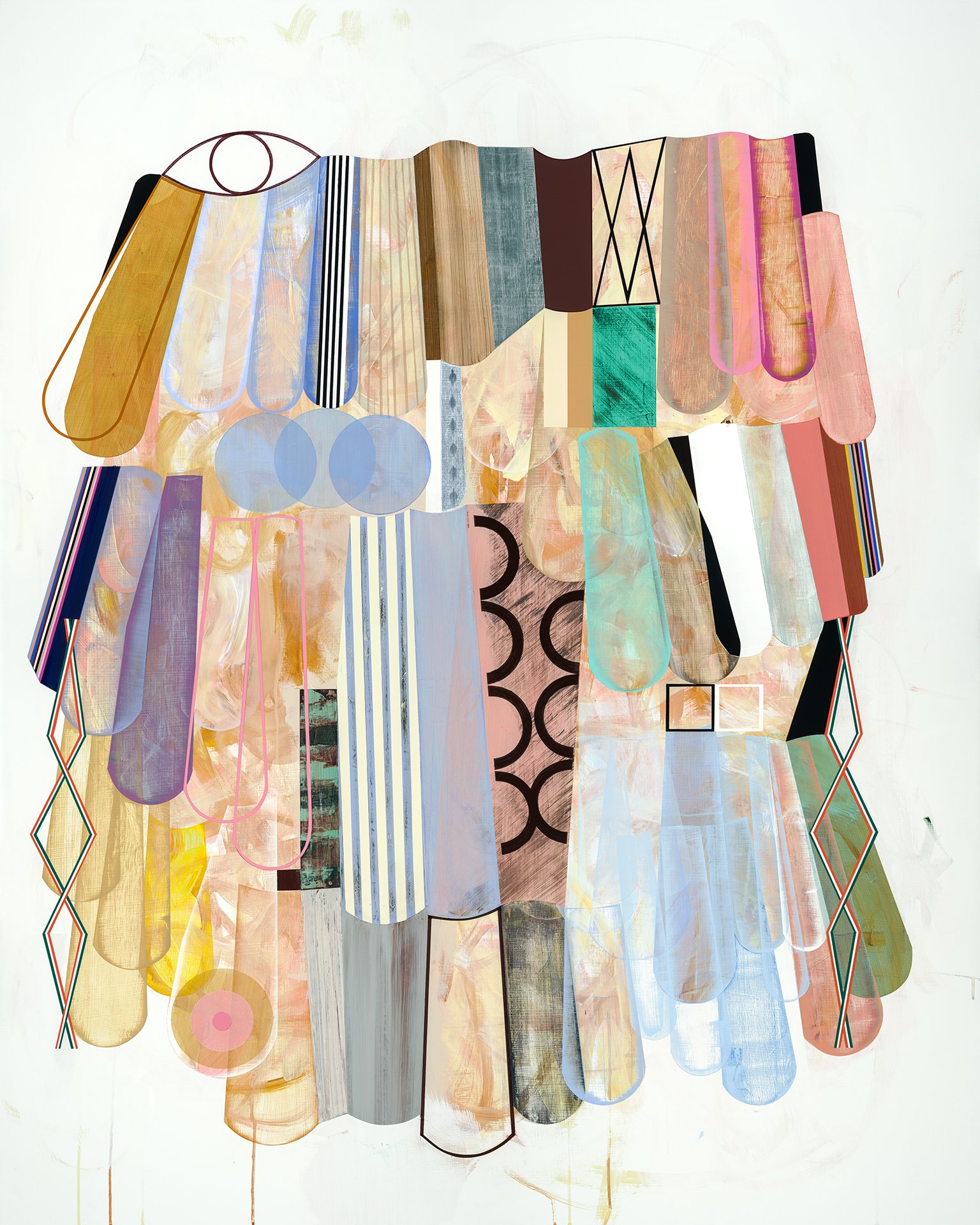“Ruche” | acrylic on canvas | 72 x 60 in.
This painting served as a grounding practice during a pivotal time in my life—the period between my daughter turning 18 and my own 50th birthday this year, as well as preparing her (my youngest) to leave for college. I found that while approaching these big transitions I was obsessing over time–counting days and overthinking–and I was having a real challenge quieting my mind in the studio.
Like all my work, this painting began as a chaotic tangle of phrases, false starts, and erasures. But what is different from this piece is that I surrendered into repeating the elongated, plain shape that echoes across the entire piece. Initially I judged the repetition as too mundane, but as I showed up each day in the studio, I realized I needed this exact thing–something quite simple to focus on that almost felt like craft and served as more restful for my mind.
I drew a faint framework for shelving these “time capsules” and while I was working found that mentally, the left hand side represents the past moving toward the future, and the right hand side the future moving closer to the present. I built the piece outside-in, from both edges--the shapes approaching each other until they meet in the middle, creating diamonds when they overlap.
[Here is a link to a process video for this painting on my instagram page]
I titled the piece “Ruche” because the overall composition resembles a ruched bodice. “Ruching” is a fabric manipulation technique that involves creating folds or gathers in the fabric by sewing lines of loose stitches and then pulling the threads to bunch the material. It results in many small pleats that create a textured, rippled effect, adding volume, dimension, and visual interest to garments
Combining this idea of ruching with measuring time, the painting feels like gathering the days within this liminal space that I currently inhabit. It gives me the false sense of control that I crave, while also nodding to the themes of dress making and costume that runs through much of my work. Further, the gathering of fabric into deliberate folds mirrors how anticipation compresses our experience of time into concentrated moments of tension and release–we feel simultaneously held back and expanded when waiting for big changes. It also takes great emotional work to manage the expectancy without letting it overwhelm the present.
In addition, the ruched bodice metaphor is about the body that has carried and nurtured. I have seen my own body swell and contract bringing two children into the world. Much of my existence has shaped around and been shaped by the crucible that is motherhood. I have had little control in this process as it is mostly life working through me. Now this primary role that I have known for nearly half my life is shifting. And I know this work is not just about my personal transformation, but also about joining a lineage of women who've crossed this same threshold. Further, the bodice functioning as ceremonial costume, prepares one for initiation and thus becomes a portal. In this way painting has served me too–as an ongoing ritual and a sacred place where the veil between two worlds grows thin.
Interestingly, I later learned that the word “Ruche” also means “hive” in French. So this structured arrangement of the repeating shapes can be viewed as serving as an architectural housing for these records of the days. In this way, the piece also emphasizes the power of repetition–the active mantra of showing up, disciplined, building and building–and the salve that such focus brings.
The diamond shapes running down the center result from the overlapping of translucent capsules from both sides of the painting. They are like pivot points where time shifts from flowing toward something to flowing away from it, signifying the exact moments where anticipation crystallizes into presence. This place of convergence also provides a perspective on time and leaves room for contemplating the power we have in the present to influence our future–as well as our past.
The single black diamond represents the absolute, the void, the big empty. It's the mystery that must be entered rather than understood, the womb-space of transformation. It's that same fertile darkness from which one becomes, to which one returns, and now from which one is born into the next iteration.










